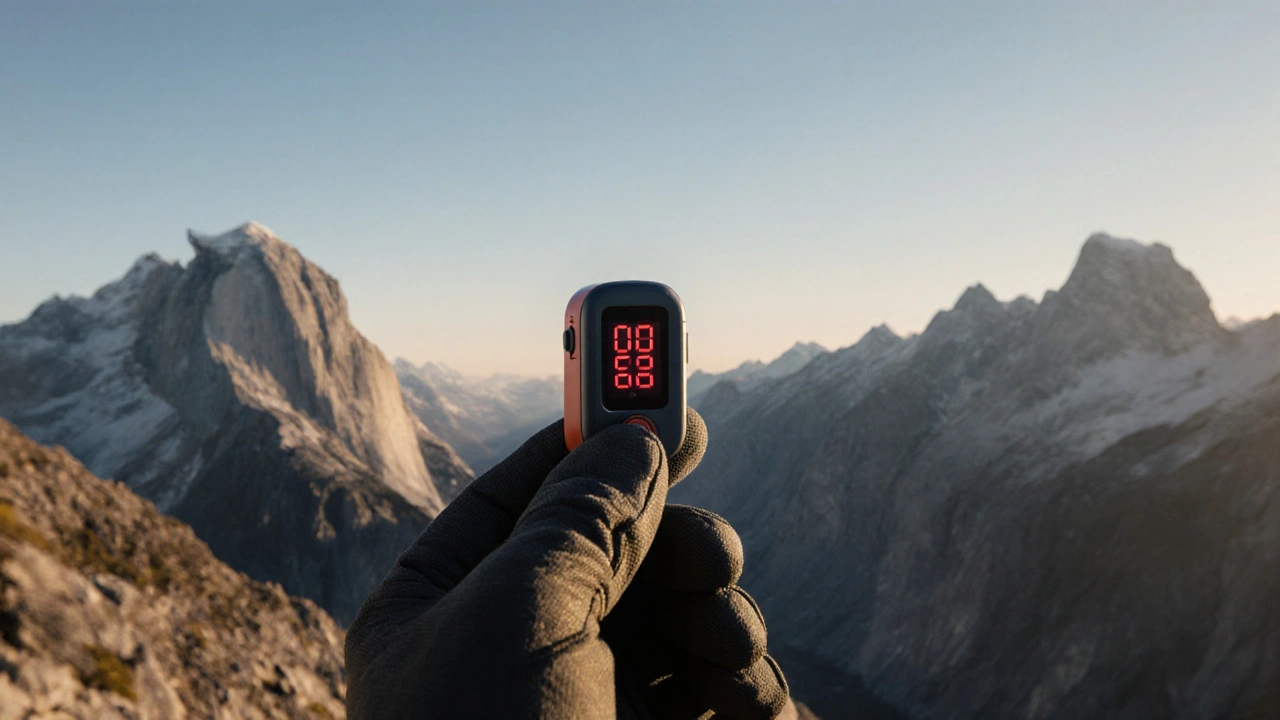Altitude Sickness Risk Checker
Check Your Altitude Sickness Risk
Fill in the form below to assess your risk of developing altitude sickness based on ascent rate and symptoms.
Ever felt a throbbing headache after a short hike at 9,000 feet and thought it was just a bad morning? That could be the first hint of mountain sickness, a condition that catches many outdoor enthusiasts off guard. Spotting the warning signs early can be the difference between a safe trek and a medical emergency.
Quick Takeaway
- Headache, nausea, and dizziness are the most common early symptoms.
- Monitor breathing rate and oxygen saturation every few hours.
- Stay hydrated, limit ascent to 1,000ft per day above 8,000ft.
- If symptoms worsen, descend 1,000ft or more and rest.
- Seek professional help if confusion, loss of coordination, or severe shortness of breath appear.
What Is Mountain Sickness?
Mountain Sickness is a condition caused by reduced oxygen pressure at high elevations. It’s also known as Acute Mountain Sickness (AMS). The body’s inability to adapt quickly enough to lower oxygen levels triggers a cascade of physiological responses that show up as recognizable symptoms.
Why Early Detection Matters
The brain and lungs are the first organs to feel the strain of hypoxia. Catching the problem when it’s just a light headache or mild nausea lets you pause, hydrate, and adjust your ascent plan before the situation escalates into high‑altitude pulmonary edema (HAPE) or high‑altitude cerebral edema (HACE), both of which can be life‑threatening.
Common Early Signs
Each sign can appear alone or together, often within the first 24hours after gaining altitude.
- Headache: A dull, pressure‑like pain behind the eyes or temples that doesn’t improve with over‑the‑counter painkillers.
- Nausea or loss of appetite: You might feel queasy, vomit, or simply not want to eat.
- Dizziness or light‑headedness: A spinning sensation that worsens when you stand up quickly.
- Fatigue: Unexplained tiredness even after a short rest.
- Sleep disturbances: Frequent waking, rapid breathing during sleep, or vivid dreams.
Notice that these symptoms are mild and often mistaken for normal travel fatigue. That’s why you need a systematic way to track them.
How to Monitor Your Body on the Trail
Using objective tools helps confirm what your senses tell you.
- Pulse Oximeter is a hand‑held device that measures blood oxygen saturation (SpO2) and heart rate. Aim for an SpO2 reading above 90%; anything lower warrants a pause.
- Track your breathing rate. A normal resting rate at sea level is 12‑20 breaths per minute; at altitude, an increase of more than 5 breaths can signal stress.
- Keep a symptom journal. Note the time, altitude, and intensity (scale 1‑10) of any headache, nausea, or dizziness.

Prevention Strategies Before You Set Off
Good preparation reduces the odds of hitting the early warning zone.
- Acclimatization is a physiological process where the body adapts to lower oxygen by producing more red blood cells. Spend a night at intermediate altitude before pushing higher.
- Limit ascent to roughly 1,000ft (300m) per day once you’re above 8,000ft (2,500m). Include a rest day every 3‑4 days.
- Stay well‑hydrated. Aim for at least 3L of water daily; dehydration worsens hypoxia symptoms.
- Consider prophylactic medication. Acetazolamide is a carbonic anhydrase inhibitor that speeds up acclimatization by stimulating breathing. Typical dose is 125mg twice daily, started 24hours before ascent.
- Avoid alcohol and heavy meals before climbs; both depress respiration.
What to Do If Early Symptoms Appear
Don’t panic-take action.
- Stop Ascending: Stay at your current altitude for at least 24hours.
- Hydrate and Eat Lightly: Sip water, electrolytes, and consume carbohydrate‑rich snacks.
- Rest: Reduce physical exertion; sit or lie down if you feel dizzy.
- Use Medication: If you’re on acetazolamide, continue the regimen; consider a single dose of ibuprofen for headache relief.
- Descend If Needed: A drop of 1,000ft (300m) often alleviates symptoms quickly.
When to Seek Medical Help
Some signs indicate the condition is moving beyond mild AMS into serious territory.
- Persistent vomiting that prevents fluid intake.
- Severe shortness of breath at rest.
- Confusion, inability to think clearly, or slurred speech.
- Loss of coordination (ataxia) - trouble walking in a straight line.
- Chest tightness or cough producing frothy pink sputum (possible HAPE).
If any of these appear, descend immediately and seek professional medical evacuation if you’re remote.
Quick Reference Checklist
| Sign | Early (AMS) | Severe (HAPE/HACE) |
|---|---|---|
| Headache | Common, mild‑to‑moderate | Often accompanied by confusion |
| Nausea/Vomiting | Occasional, tolerable | Persistent, prevents hydration |
| Dizziness | Light‑headed, improves with rest | Severe, leads to loss of balance |
| Shortness of Breath | Increased rate with exertion | Resting dyspnea, cough with pink froth |
| Neurological | Sleep disturbance | Confusion, hallucinations, ataxia |
Final Thoughts
Mountain environments are beautiful but unforgiving. By learning to spot the first whispers of Altitude the elevation above sea level where oxygen pressure drops‑related stress begins, you give yourself a built‑in safety net. Stay aware, monitor your vitals, and never hesitate to turn back. The summit will still be there tomorrow, and you’ll be in a much better shape to enjoy it.
Frequently Asked Questions
How long does it take for mountain sickness to develop?
Symptoms usually appear within 6‑24hours after a rapid ascent above 8,000ft (2,500m). The exact timing varies with fitness, hydration, and how quickly you climbed.
Can I prevent mountain sickness without medication?
Yes. Gradual ascent, proper hydration, avoiding alcohol, and allowing extra rest days are the most effective non‑pharmacological measures.
Is a headache always a sign of mountain sickness?
A headache is the most common early symptom, but it can also be caused by dehydration, lack of sleep, or a simple migraine. Pair the headache with other altitude‑related signs to be sure.
What role does Hypoxia the deficiency of oxygen reaching body tissues play in mountain sickness?
Hypoxia triggers the body’s stress response: increased breathing, higher heart rate, and fluid shifts that cause the classic symptoms. The severity of hypoxia rises with altitude, which is why early detection is crucial.
Should I use a pulse oximeter at every stop?
Checking SpO2 every 2‑3 hours during a fast ascent is a good practice. Consistently low readings (<90%) signal the need to rest or descend, even if you feel fine.
When is it safe to continue after mild symptoms improve?
If symptoms have resolved for 24hours, SpO2 is >90%, and you’ve rested adequately, you can consider a modest ascent (no more than 500ft) and continue monitoring closely.


Write a comment